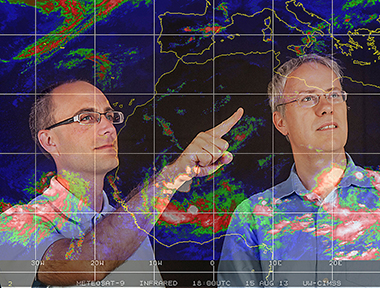Six UAlbany Atmospheric Scientists Receive Federal Grants to Aid Extreme Weather Prediction and Alleviate Global Water Crisis
 |
|
Ryan Torn (left) of the Department of Atmospheric and Environmental Sciences, is the recent recipient of a NOAA grant to improve prediction of tropical cyclone intensity and structure. He stands with department chair Christopher Thorncroft. (Photo by Mark Schmidt) |
ALBANY, N.Y. (October 30, 2014) — An array of recent federal government awards to University at Albany atmospheric scientists aim at improving the prediction of extreme weather events and addressing the management of critical water resources, both locally and globally.
The projects, conducted by one of the largest university-based concentrations of weather and climate scientists in the country include researchers and their teams from UAlbany’s Department of Atmospheric and Environmental Sciences (DAES) and Atmospheric Sciences Research Center (ASRC). The awards range from one to four years in duration, and include, by funding agency:
National Oceanic and Atmospheric Administration (NOAA)
Paul Roundy, DAES: Precursor Conditions to Onset and Breakdown of Agricultural Drought over the United States Corn Belt Region (3 years)
Roundy’s project will broaden NOAA's drought monitoring and prediction systems by understanding the predictability of past droughts and advancing the development of a national drought monitoring and prediction system. The work will generate a 60-year record of the onsets and termination dates of agricultural drought events in the United States Midwest Corn Belt Region.
Jiping Liu, DAES: Development of Satellite-Based Surface Fluxes of Heat and Moisture in the Arctic Ocean for Understanding Impacts of Changing Arctic Environments (3 years)
Liu’s project targets the development of new satellite retrievals and approaches to computing surface fluxes. These concepts will provide critical insight into impacts of rapid changes of Arctic Ocean environments on climate variability and meaningful evaluation of NOAA-supported climate model simulations. While improving knowledge of exchanges of heat and moisture fluxes between the oceans and the atmosphere is critical to understanding the energy and water cycle and climate variability, this is particularly true in the Arctic, where rapid environmental changes are occurring, but where flux data is currently inadequate due extreme cold and remoteness.
Ryan Torn, DAES: Assessing the Predictability of Tropical Cyclone Intensity using HWRF (2 years)
Numerical model predictions of tropical cyclone (TC) intensity and structure suffer from deficiencies associated with initial conditions and model formulation. Torn and his team will study how errors in the Hurricane Weather Research and Forecasting (HWRF) model’s initial conditions impact subsequent forecasts of TC intensity and wind structure. The project will ultimately attempt to develop a statistical algorithm that can be used by forecasters to place confidence bounds on their TC forecasts.
Cheng-Hsuan Lu, ASRC: Improving Cloud Microphysics and Their Interactions with Aerosols in the NCEP Global Models (2 years)
Lu leads a coordinated ASRC-National Centers for Environmental Prediction (NCEP)-Global Modeling and Assimilation Office project. It is aimed at enhancing NOAA/NCEP’s weather-climate modeling capabilities by improving understanding of the processes relevant to aerosol-cloud-radiation interactions in the NCEP global models. The project will also contribute toward achieving the first climate objective of NOAA’s Next Generation Strategic Plan: an improved scientific understanding of the changing climate system and its impacts, by way of enhanced understanding and modeling, and predictions and projections.
National Science Foundation (NSF)
Aiguo Dai, DAES: Natural Variations and Forced Changes in Historical and Future Precipitation and Drought (3 years)
Dai is studying more than a century of climate simulations in order to differentiate natural from man-induced forces affecting global drought and precipitation. The study’s results will help interpret recent extreme climate events, such as droughts and heat waves in the Southwest U.S., and could reveal critical information on how drought brought on by global warming may affect farmers, water resource managers, policymakers and other stakeholders in the U.S. and other countries.
U.S. Navy Office of Naval Research (ONR)
Lee Harrison, ASRC, High-Density Drop-Sonde Measurements for Hurricane Research (4 years)
Harrison’s project seeks improvements in the HDSS-XDD drop-sonde system released from high-altitude research aircraft to make measurements of hurricanes. His objectives are much enhanced drop-sonde spatial resolution, particularly for improving forecasts of intensification and facilitating ONR’s experiments with “outflow,” i.e., air flowing outward from a storm system. The work includes enhancements to the XDD sondes and their sensors and the creation of algorithms that will improve the accuracy and reliability of the sondes’ data recovery.
U.S. Department of Energy (DOE)
Aiguo Dai, DAES: Collaborative Research to Narrow Uncertainties in Precipitation and the Hydrological Cycle in Climate Models, (3 years)
Climate models exhibit exceedingly large disparities with observations for precipitation — critical for determining water availability, a major 21st Century local and global concern. Dai’s study will enable improved evaluation of model precipitation by better determining observed precipitation and its uncertainties; evaluate all aspects of precipitation characteristics to isolate the main regions, processes, and times where major issues are apparent; explore interannual and decadal variability; and work with modelers in the National Center for Atmospheric Research to find new parameterizations to improve characteristics of precipitation.
![]() For more news, subscribe to UAlbany's RSS headline feeds
For more news, subscribe to UAlbany's RSS headline feeds
A comprehensive public research university, the University at Albany-SUNY offers more than 120 undergraduate majors and minors and 125 master's, doctoral and graduate certificate programs. UAlbany is a leader among all New York State colleges and universities in such diverse fields as atmospheric and environmental sciences, business, education, public health,health sciences, criminal justice, emergency preparedness, engineering and applied sciences, informatics, public administration, social welfare and sociology, taught by an extensive roster of faculty experts. It also offers expanded academic and research opportunities for students through an affiliation with Albany Law School. With a curriculum enhanced by 600 study-abroad opportunities, UAlbany launches great careers.


